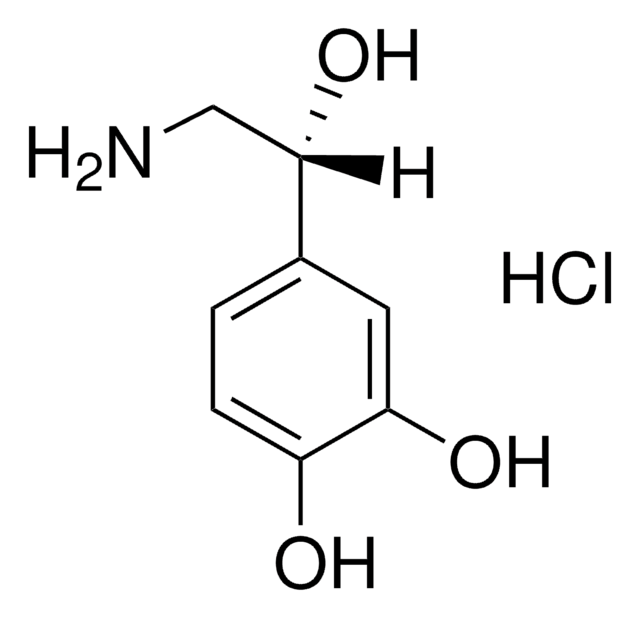The information you are requesting can be supplied by our Technical Service team who can assist you further. We kindly ask you to navigate to the link https://www.sigmaaldrich.com/techservice, and click on "Product Technical Inquires" under the Products Section with all the required information so that a member of our team can reach out to you to assist further. Thank you.
E4642
(±)-Epinephrine hydrochloride
≥98% (TLC), powder, adrenergic receptor agonist
Synonym(s):
(±)-Adrenalin, 4-(1-Hydroxy-2-[methylamino]ethyl)-1,2-benzenediol hydrochloride
Select a Size
Select a Size
About This Item
Recommended Products
Product Name
(±)-Epinephrine hydrochloride,
Quality Level
solubility
H2O: 50 mg/mL
storage temp.
2-8°C
SMILES string
OC(CNC)C1=CC=C(O)C(O)=C1.Cl
InChI
1S/C9H13NO3.ClH/c1-10-5-9(13)6-2-3-7(11)8(12)4-6;/h2-4,9-13H,5H2,1H3;1H
InChI key
ATADHKWKHYVBTJ-UHFFFAOYSA-N
Gene Information
human ... ADRA1A(148) , ADRA1B(147) , ADRA1D(146) , ADRA2A(150) , ADRA2B(151) , ADRA2C(152) , ADRB1(153) , ADRB2(154) , ADRB3(155)
Looking for similar products? Visit Product Comparison Guide
General description
Application
- in the induction of renalase expression in Human renal proximal tubular epithelial cells[4]
- in the infusion studies to test its effect on heart rate and eye temperature measurements in bull[5]
- as a medium supplement for the stimulation of endothelial progenitor cells[6]
Biochem/physiol Actions
Other Notes
Signal Word
Danger
Hazard Statements
Precautionary Statements
Hazard Classifications
Acute Tox. 3 Dermal - Acute Tox. 3 Oral - Eye Irrit. 2 - Skin Irrit. 2 - STOT SE 3
Target Organs
Respiratory system
Storage Class Code
6.1A - Combustible acute toxic Cat. 1 and 2 / very toxic hazardous materials
WGK
WGK 3
Flash Point(F)
Not applicable
Flash Point(C)
Not applicable
Personal Protective Equipment
Choose from one of the most recent versions:
Already Own This Product?
Find documentation for the products that you have recently purchased in the Document Library.
Customers Also Viewed
-
est ce que l'epinephrine de degrade a 37C et est ce qu'il est reversible?
1 answer-
Helpful?
-
-
Can it be stored at -20C
1 answer-
The recommended storage temperature for this product is 2-8°C. In general, powder materials are not affected by freezer storage, however, this item has not been tested under these storage conditions.
Helpful?
-
-
Hi, Do you have the ratio/ amount of D- and L-adrenaline in this product?
1 answer-
The ratio of +/- adrenaline is not determined.
Helpful?
-
Active Filters
Our team of scientists has experience in all areas of research including Life Science, Material Science, Chemical Synthesis, Chromatography, Analytical and many others.
Contact Technical Service










